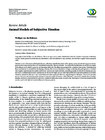
Open access
Author
Date
2014Type
- Review Article
Abstract
Tinnitus is one of the major audiological diseases, affecting a significant portion of the ageing society. Despite its huge personal and presumed economic impact there are only limited therapeutic options available. The reason for this deficiency lies in the very nature of the disease as it is deeply connected to elementary plasticity of auditory processing in the central nervous system. Understanding these mechanisms is essential for developing a therapy that reverses the plastic changes underlying the pathogenesis of tinnitus. This requires experiments that address individual neurons and small networks, something usually not feasible in human patients. However, in animals such invasive experiments on the level of single neurons with high spatial and temporal resolution are possible. Therefore, animal models are a very critical element in the combined efforts for engineering new therapies. This review provides an overview over the most important features of animal models of tinnitus: which laboratory species are suitable, how to induce tinnitus, and how to characterize the perceived tinnitus by behavioral means. In particular, these aspects of tinnitus animal models are discussed in the light of transferability to the human patients. Show more
Permanent link
https://doi.org/10.3929/ethz-b-000083636Publication status
publishedExternal links
Journal / series
Neural PlasticityVolume
Pages / Article No.
Publisher
HindawiMore
Show all metadata


